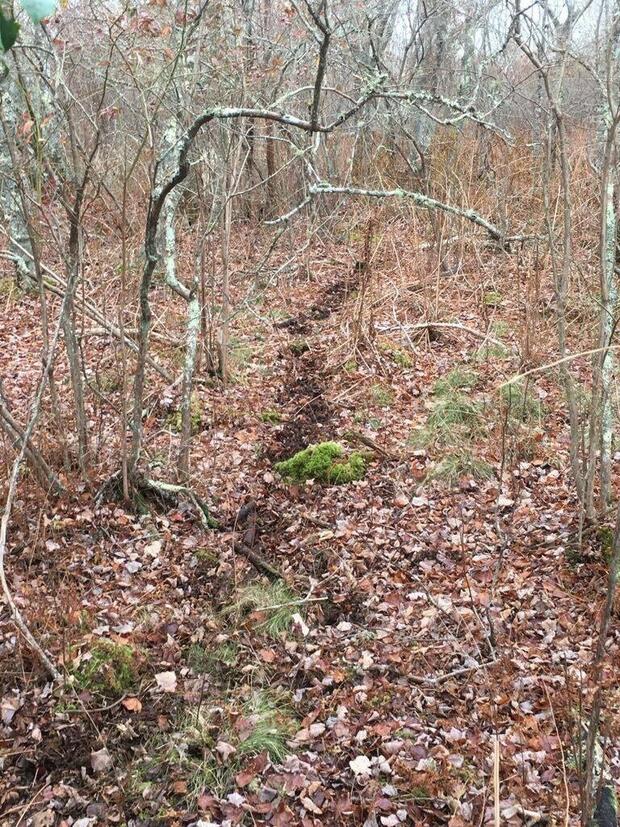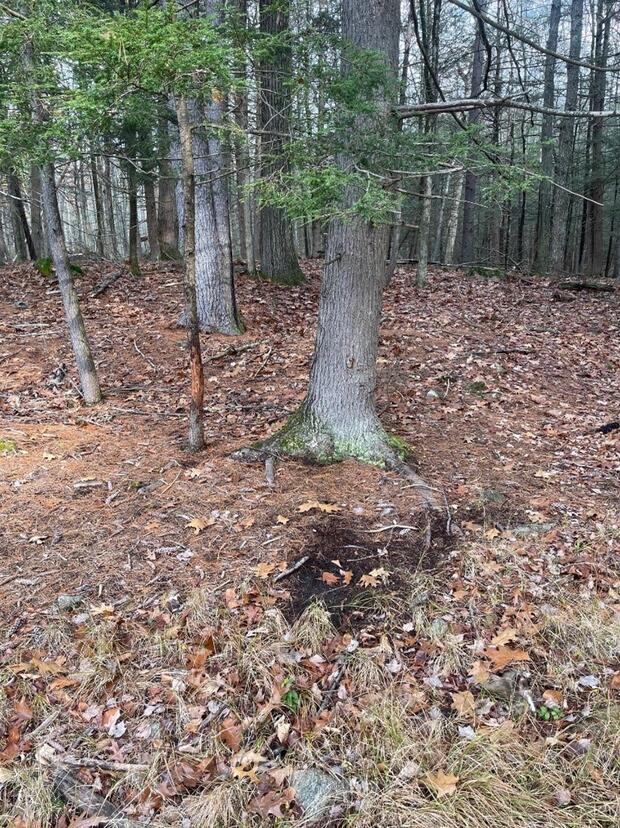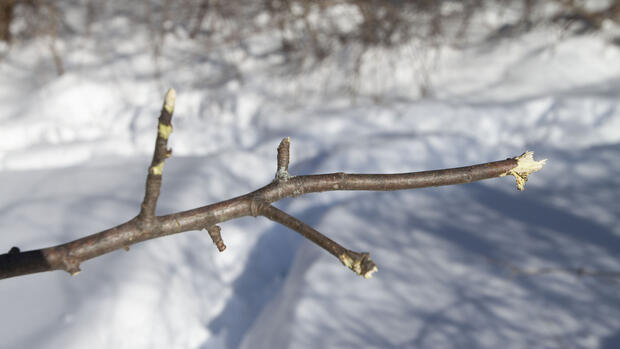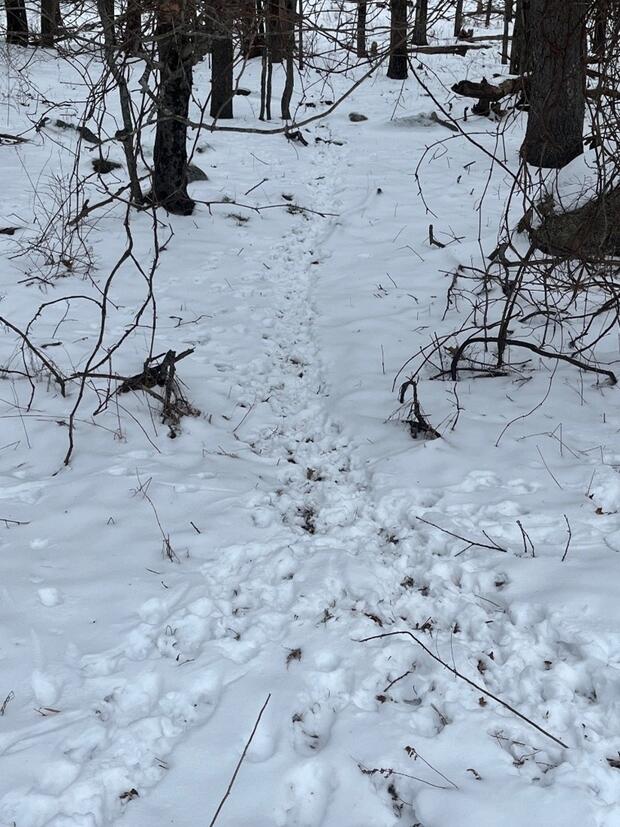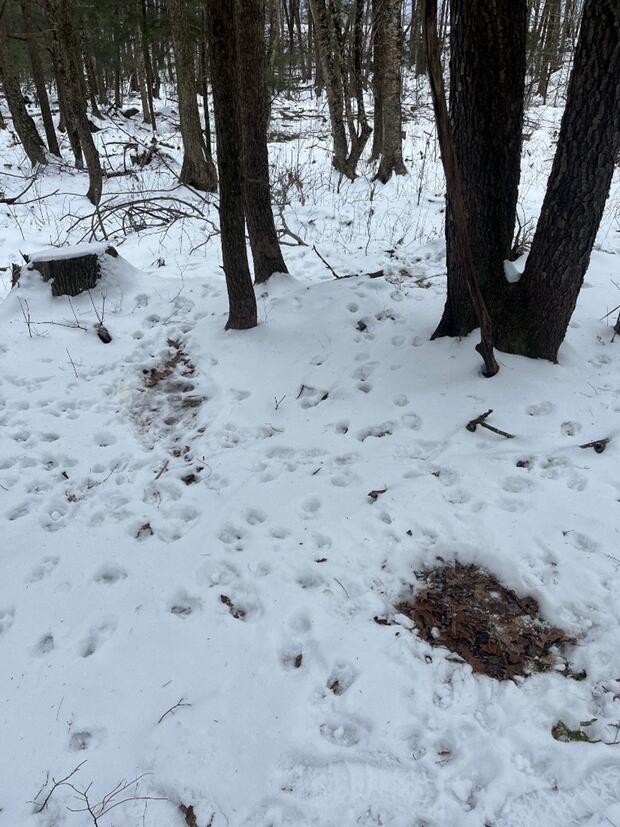Why scout in the winter?
Even though food resources and bedding preferences shift with the change of the seasons, hunters can learn a lot about deer behavior and patterns by winter scouting. The more time you spend in the field connecting different pieces of information, the more success you are likely to have during the open season. There are lots of reasons to spend some time scouting this winter:
- Enhanced visibility. The reduction of canopy and understory leaves makes it much easier to see sign left by deer in the fall. Travel corridors of rutting bucks and bedding areas become visible and give hunters a more complete picture of deer movement and behavior.
- Improved tracking with snow cover. The presence of snow can reveal information about deer movement patterns and the ways deer use different parts of a landscape.
- Location planning. Treestand placement is an art. You want to get as close as possible to where deer will likely be, while remaining undetected while hunting. Gathering information about deer movement and behavior patterns throughout the year can help make decisions about where to set up in the fall.
- Less activity. Scouting in the winter means you won’t be disturbing deer before or during the hunt. With fewer people in the woods, your chances of encountering other wildlife increase, especially if you’re walking quietly on fresh snow.
- Keep the excitement going. Winter scouting is a great reason to get back outside and stay active. Finding deer sign left by secretive bucks that made it through the season can really fuel a hunter's imagination and motivation for the upcoming seasons.
General tips
- Don’t be afraid to explore the landscape extensively. You may find it helpful to take notes and set GPS pins on your device along the way.
- If there is safe ice, you can access and explore swamps and wetlands more easily in the winter. You’ll likely find a treasure trove of buck sign in those areas. Look for runs that enter or exit wetland areas. This is a great place to set up during deer season.
- Winter is the perfect time to put boots on the ground in new areas. Without leaves, it’s easier to identify spots to enter a hunting location and find safe roadside access.
- Post-season scouting can reveal information about hunting pressure in an area you’re interested in. Many hunters choose not to remove their stands and cameras after the season, and they are easy to spot without leaf cover. Take notes or mark points on an app to keep track of potential conflicts.
- If you plan to set up a treestand, you may be able to pick out gaps where natural shooting lanes exist more easily during the winter.
Features to look for
- Runs or travel corridors that were identified in warmer months can easily be explored when leaves have fallen. Walk these runs in both directions. You will likely find hotspots of sign along the way that will stand out due to clusters of rubs on trees or scrapes on the ground. You may locate areas where multiple runs converge—these areas can be very productive treestand locations.
Heavily-used late winter deer run - Rubs and scrapes are created by bucks during the fall but remain visible until spring arrives.
Deer scrape and rub - Winter food sources can be different from those available during the fall. Having some background knowledge of winter food sources can help narrow down your search for sign. In winter, when most of the acorns and hickory nuts have been consumed, deer start to rely on buds, twigs, and stems from new growth and young trees. Look along the edges of swamps and the re-growing edges of logged areas for the nibbled and chewed ends of young woody growth. In times of food scarcity, deer may resort to browsing on evergreen vegetation such as pines and laurel. Vegetation that has been browsed will have broken stems and twig ends from the ground up to about 5 feet high.
Young woody growth chewed by deer - Benches, saddles, and funnels are larger landscape features that can help you predict where deer are likely to bed and travel. With fewer leaves, these topographic features become easier to identify while out scouting.
- Benches are flat areas on a hill or slope. If you are walking on a hillside and see a flat area, that is a bench. Deer often bed along benches to more easily smell or see approaching danger. Benches on the southern or eastern side of a slope provide deer with cover from heavy cold wind in winter and are warmed more quickly by the sun. Look for signs of beds in these areas.
- Saddles are low areas between two higher points along a ridgetop. If you’re walking a ridge and the elevation drops and then climbs again, look for tracks in this area. Deer often travel through these lower areas.
- Funnels are formed when two features (a steep change in elevation, a physical barrier like a river, or a habitat feature like thick cover or even an open field) cause a deer to travel through a predicable area between the features. Walk along the funnel to look for signs of consistent deer travel.
Using snow to your advantage
Scouting with snow on the ground is extremely helpful. Snow provides clear information about where deer are traveling and will lead the inquisitive hunter to bedding and feeding areas.
- Wait a few days or even weeks (if the temperatures allow) after a snowfall. This allows tracks and other sign to build up. After time has passed, it is fairly easy to tell the age of deer sign (older versus newer) and this can help you determine how frequently deer are traveling through an area.
Active deer run near a food source - Deep snow can limit the amount of area you can cover while scouting and doesn’t reveal as much sign. Snow under 6 inches is easy to navigate and highlights sign well.
- Snow makes it easier to locate bedding areas. You’ll be able to see the impressions made in the snow by resting deer and if the snow has completely melted, the contrast of the brown ground will stand out against the snow and be even more visible. Take note of the terrain and cover where you have found beds or drop a pin in your GPS app.
Note: Deer sign like bedding and feeding locations may change throughout the year, but winter scouting will provide valuable information that can set you on the right track when fall rolls around.Two beds near an active deer run
